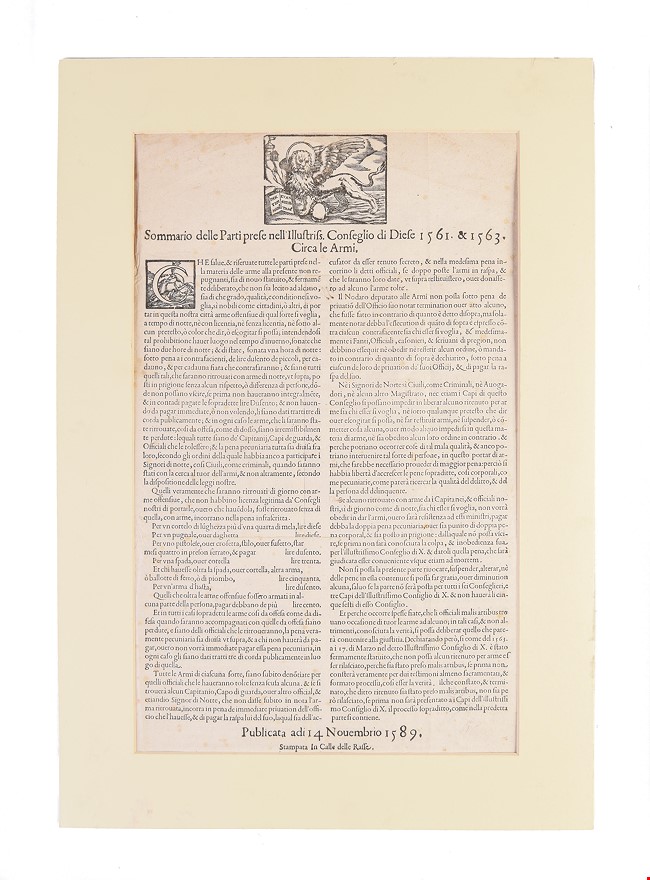Sommario delle Parti prese nell'illustriss. Conseglio di Diese 1561. & 1563. Circa le Armi.
COUNCIL OF TEN (1589.)
£1750.00
THE 'TRIBUNAL OF BLOOD' REGULATES THE CARRYING OF WEAPONS
With woodcut arms of the Republic of Venice, featuring the lion of St Mark, woodcut initial.
Single sheet (425x275mm) printed on paper, one side only, tipped in to window mount (small hole not affecting legibility, minor spotting, otherwise very good condition).
Calle delle Rasse, Venice, 14 November,
The only copy found of this broadside, restating stringent regulations regarding the carrying of personal weapons in the city of Venice, first issued in 1561 and again in 1563.
Issued by the Council of Ten - Consiglio di Dieci - the 'severest and most feared of Venetian constitutional bodies' (G. Cozzi, 'Authority and the Law in Renaissance Venice', in J. R. Hale, Renaissance Venice (London, 1973), p.294) responsible for security and intelligence in the Republic, this proclamation describes the laws regarding carrying arms, and the punishments to be meted out to those in violation. The rules differ according to time of day. Carrying any form of weapon at night, it begins, is completely prohibited, even for those in possession of an arms licence, from two hours after sunset in winter, and one hour after sunset in summer. The punishments are severe. In all cases, weapons will be immediately confiscated, and in addition, those found carrying will be subject to a fine of 200 lire per person, and a further 200 per weapon confiscated. Those who fail to pay will be imprisoned; those who refuse to pay or do not pay fast enough will be publicly subjected to the standard three sessions of 'tratti di corda', a form of corporal punishment in which the individual was restrained with hands tied behind their back, and raised by a rope attached to their wrists.
During the day, the rules vary. Those found with weapons without an official licence to own or carry are subject to a penalty, which varied according to the nature of the weapon. Shorter knifes - cortelo, pugnale, daghetta - are subject to a fine of 10 lire; longer knives - pistolese (known as a lengua de vaca, a cow's tongue, similar to a machete in shape), stiletto, fusetto and crosetta incur four months in prison and 200 lire; a spada, side sword, or cortella, thirty lire; a weapon of iron/lead - presumably a gun or pistol - in addition to a dagger, 50 lire; a polearm, 200 lire, and those with arms anywhere else on their person, in addition to the above stated, 100 lire. An interesting distinction is drawn between defensive and offensive weapons, with the possession of offensive weapons incurring an escalation in punishment; in all cases the weapon(s) shall be immediately confiscated, and if the fine is not immediately paid, the individual shall, again, be subject to torture by tratti di corda, in a public place.
Those who resist or refuse the instructions of the guard or official shall receive double the fine, double the length of torture, and thrown in prison; they will be unable to leave prison without their crime first being discussed by the Council of Ten, who will decide whether they merit being put to death. Interestingly, a portion of the text of this proclamation outlines the punishment meted out to law enforcers who either do not report the discovery, return the confiscated weapon to the lawbreaker, or supply it to someone else.
Whether this proclamation related to a precise instance or period of social unrest in Venice is uncertain, though violence was 'a common feature of early modern Italian life' (V. Bartels, 'Defence, Honour and Dress', Refashioning the Renaissance (accessed online)) and we have found numerous proclamations issued throughout the sixteenth and early seventeenth century by the Council of Ten (all in 4to format) prohibiting arms - arquebuses in particular, in several instances - banditry, assassination, and duels.
Civil unrest 'surged from two connected wellsprings, interest and honor, both rooted in the anthropological bedrock of Mediterranean sociability [...] The more frequent violence was, the more it was tolerated and the more the pretexts for it seemed trivial' (Hanlon, 'Violence and its Control in the Late Renaissance: An Italian Model', A Companion to the Worlds of the Renaissance (Blackwell, 2002), p.140). Although duels had been banned earlier in the sixteenth century, towards the end of the century the Republic, particularly the mainland, faced a serious problem with bands of private, often noble-led bandits; it may be that this legislation, in both its first issue in the 1560s and in its present iteration, was one of 'a series of legislative measures which aimed at stemming criminality by making the penalties more severe even for those who favoured or at least tolerated it' (S. Lavarda, 'Banditry and Social Identity in the Republic of Venice', Crime, Histoire & Sociétés, 11.1, 2007, p.4). More superficially, smaller 'defensive' weapons, like daggers and stilettos, were a feature of male fashion in the sixteenth century which made carrying them even more of a commonplace; the difference in fines outlined in this legislation between that for smaller, perhaps more fashionable 'weapon' - 10 lire - and the more offensive - upwards of 200 lire - suggests that the authorities recognised that distinction, although prison and corporal punishment were threatened for both.
We have found no other copies of these regulations in broadside format; of the earlier incarnations of 1561 and 1563 referenced in the title we have found only quarto pamphlet versions of the 1563 regulations (at the Bib. Casanatense, Rome; Bib. d'arte del Museo civico Correr and Bib. Naz. Marciana, Venice; Bib. Civ., Padova; Bib. Civ. Angelo Mai, Bergamo). Of earlier regulations regarding the carrying of arms, arquebuses, civic violence and so on we have found only quarto pamphlet editions. For further details, please enquire..
Stock Code: 244101




